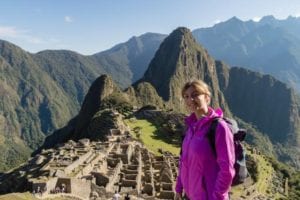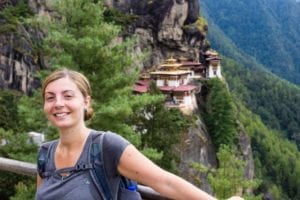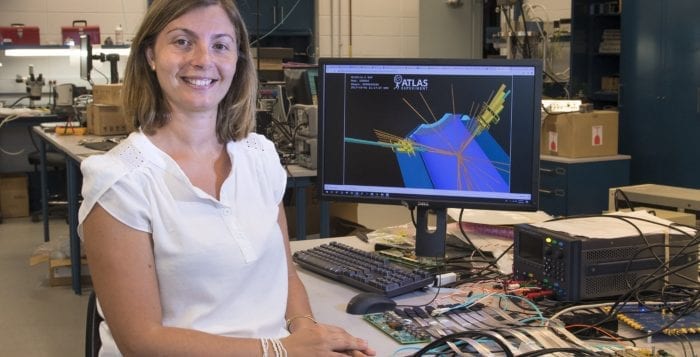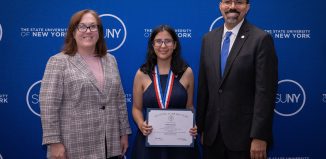BNL’s Viviana Cavaliere scores DOE award to search for new particles
By Daniel Dunaief
The United States has been the site of important life events for Italian-born Viviana Cavaliere. When she was in high school, she went to Montana, where she changed her mind about her life — she had wanted to become an architect — and decided that science was her calling.
Later, when she did a summer student program at Fermilab near Chicago, she met her future husband Angelo Di Canto, who is also a physicist.
While Cavaliere has been an assistant physicist at Brookhaven National Laboratory since 2017, she has been living in Switzerland, where she has been working at CERN. She is preparing for a move this month to Long Island, where she hopes to find new physics phenomena, including new particles, using the Atlas detector at the Large Hadron Collider at CERN.

Cavaliere will return to the United States with a vote of confidence in her potential and some financial support. The Department of Energy recently announced that she was the recipient of $2.5 million over five years as a part of the Office of Science’s Early Career Research Program.
“I am very honored,” said Cavaliere, who will use the funds to support the research of postdoctoral scientists in her lab, to buy equipment and to travel to conferences and to CERN.
At the heart of her research is a desire to search for new particles and new phenomena that might build on the Standard Model of particle physics.
Cavaliere is coordinating a group of about 400 physicists who are looking for new particles. Her role is to analyze the data from the Large Hadron Collider.
Indeed, officials at the Department of Energy said that Cavaliere was one of only three recipients in the Energy Frontier Program from a pool of 23 applicants because of her role at CERN.
The award “requires those who have shown leadership capability,” said Abid Patwa, program manager for the Energy Frontier Program and special assistant for International Programs in the DOE Office of High Energy Physics. Cavaliere has “already been participating and leading” studies.
Michael Cooke, who is a program manager in the Office of High Energy Physics in the Department of Energy’s Office of Science, said Cavaliere’s work fits the description of a “high risk and high reward” proposal that could “steer the field in new directions.”
By using new software, Cavaliere will mine data produced in a microsecond, which is 10 to the negative sixth of a second, for ways to filter specific events.
Patwa suggested that his office urges principal investigators to be as “quantitative as possible” in their work, so that they can show how their efforts will be successful.

Cavaliere is not only conducting scientific research but is also part of the technological innovations.
“It helps a person’s career that they understand all aspects of what is involved in running these major experiments,” Patwa said.
Collaborators are encouraged to have balanced roles in research and hardware operations or upgrade activities, Patwa explained in an email.
Cavaliere was at CERN when the elusive Higgs boson particle was discovered in 2012. The particle, which is called the “God” particle, had been proposed 48 years earlier. The Higgs boson explains why particles have mass.
“It was a very exciting day, you could feel the joy in the corridors and I believe it was one of those days where nobody could concentrate on work waiting for the official release of the news,” Cavaliere recalled. “At the time, I thought it would be great if we had more days like those, with the excitement of the discovery.”
Cooke said that extending the work from the Higgs boson could offer promising new clues about physics. He described how Cavaliere is making high precision measurements of particle interactions involving the Higgs boson. Any discrepancy between what she finds and the predictions of the Standard Model could be a hint of new particles, he explained in an email.
“Not only will her analysis advance the field by improving the search for new physics, but the new tools she creates to capture the best data from the [Large Hadron Collider] will be applicable much more broadly,” Cooke said.
Patwa, who worked at BNL as a postdoctoral research associate and then as a staff scientist from 2002 to 2012, explained that he is “encouraged by the talented researchers joining BNL as well as other DOE national laboratories and universities.” He believes the award is a testament to her past accomplishments and to her current objectives.
When she was growing up in a town near Naples in southern Italy, Cavaliere had to choose whether to attend a classical high school or a school focused on math and physics. Particularly interested in history, she decided to study at a classical school.
During her senior year of high school, she traveled on an exchange program to Montana, where she did experiments in the lab with a “very, very good teacher. I started liking science and was undecided between chemistry and physics.”
The travel experience to the Big Sky state “opened my mind, not only about what you do in the future, but also gives you a taste of a different culture.”
When she attended the Sapienza University of Rome, she had to catch up to her colleagues, most of whom had learned more math and physics than she. It took a year and a half to reach the same point, but she graduated with her class.
When she did her postdoctoral work in Chicago, she met Di Canto, who grew up about 100 kilometers away from her in Italy as well. “My mom always makes fun of me,” Cavaliere said, because she “found her husband in the United States.”
As for work, she is inspired to use the funds and the recognition from the DOE to build on her developing career.
“There’s always some hope you’ll find something new,” she said.







